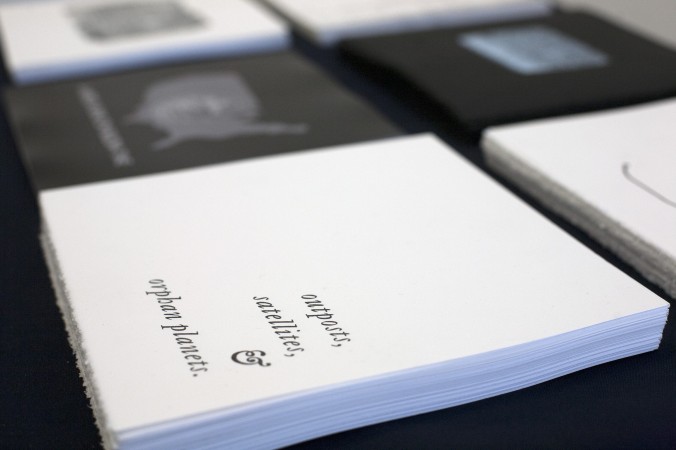In the evening, Grasshopper, an electronic duo from Brooklyn, conjured a nostalgic dreamscape — a memory of jazz in a haze of electronic pulses and hums made by a series of pedals, loops and dropping out resonances. Two acoustic trumpets and a small wind-controlled Steiner synthesizer trumpet wailed against the textures of the urban night. Jesse DeRosa and Josh Millrod, who make up Grasshopper, are both former orchestral jazz musicians and started playing ska together in 1999. They then moved on to more experimental forms, building their own electronic instrumentation, and finding a receptive audience outside prescribed institutional settings.
The theme of mutation of a machine into a quasi-sentient, climactic environment of bio-feedback continued around the corner at Eyebeam. The art and technology center is an artists’ laboratory and gallery. For Chelsea Sound, Roddy Schrock, artist and associate director of public programs at Eyebeam, invited musicians and curators D.V. Caputo and Matthew Arkell at NPContemporary, to program a mixed media show for the 21st street storefront gallery space. The building was designated by Qualia CeraSite™ a “living structure… freed from the human license agreements and suppression algorithms that once shackled it to a state of perpetual civic servitude.” The exhibition featured mixed media installation works by Laura Brothers, EOE, Ryan Whittier Hale, Daniel Leyva, Daniel Swan, and MSHR.
Birch Cooper and Brenna Murphy, two artists formerly part of the Oregon Painting Society, explore the collaborative creation of audio-visual portals to mysterious and transcendental worlds with MSHR. Their instrument for the evening’s performance, a sled-like array of electronics decorated with driftwood and prismatic tubes of mirrors, was on display throughout the day. A couple stood barefoot on exposed metal plates, tentatively touching each other’s bare skin and laughing as they completed the circuit, activating wailing oscillators. In the evening, the lights went out and incense was placed next to laser beams at the corners. Birch held a microphone close as he blew into a conch shell, invoking attention and evoking nature in this tangle of wires on a sea of glowing red and green perspex. Brenna’s droning voice was granulated, broken into chunks then stitched back together. Birch raised his light-reactive, synthesizer-gloved hands and began a low throbbing, howling, electronic pulsing, phasing reminiscent of the wind through water, trees, fences. Brenna waved a driftwood laser beam wand in front of his face and over his head. The shamanistic séance ended as they pressed their hands together and stroked each other’s faces in bursts of sonic oscillations.
I was too late to see the performances at Family Business next door. All that was left in the small shop window was a pile of gently blowing leaves, a fuming smoke machine and a projection of a forest canopy in the back left corner. They were the remnants of Forest Rangers HQ, a series of performances exploring networks of communication in the vegetable and human kingdom.
Over on 22nd street, on the 5th floor of a former warehouse building, I made it to the Electronic Arts Intermix (EAI). The organization specializes in artists’ videos, with an archive of 3,500 works by more than 200 artists. Josh Kline, Public Programs Director at EAI, selected works from the collection with performances involving sound, which included music videos and artists working with composers. The program featured a wide range of works: “Baldessari Sings Lewitt” (1972), Dan Graham and Glenn Branca’s “Performance and Stage-Set Utilizing Two-Way Mirror and Video Time Delay” (1983), Nam June Paik’s “Nam June Paik with the Bad Brains” (1991), Kalup Linzy’s “SweetBerry Sonnet (Remixed)” (2008) among others. “Music has always been a source of inspiration,” Kline explained. “Many artists started out in music scenes, and DIY scenes, and then moved into art.” EAI wanted to be involved with the festival because it brought together the community of nonprofit arts organizations located in the gallery district. “It draws attention to the fact that there are still non-commercial spaces for looking at art in the middle of Chelsea,” Kline said.
Printed Matter works with print material. Electronic Arts Intermix works with video. Eyebeam works with new media technologies. Family Business works with performance. All produced a diverse yet coherent program around artists’ sounds, which does not seem to be categorically isolated as a particular practice. Ultimately, the festival invited a closer look at DIY art forms born from an interest in music and sound. The dominant trope running through works in the festival was an attempt at communicating across boundaries through an aural medium — from human to machine, human to human, human to vegetable, human to mirrored and refracted image of the self, and, from local to wider arts community.








[…] lines and rattle crotales. Last year I happened to see him play at Printed Matter during the Chelsea Sound festival in New York, so it seemed especially appropriate that this next encounter of the percussionist and […]